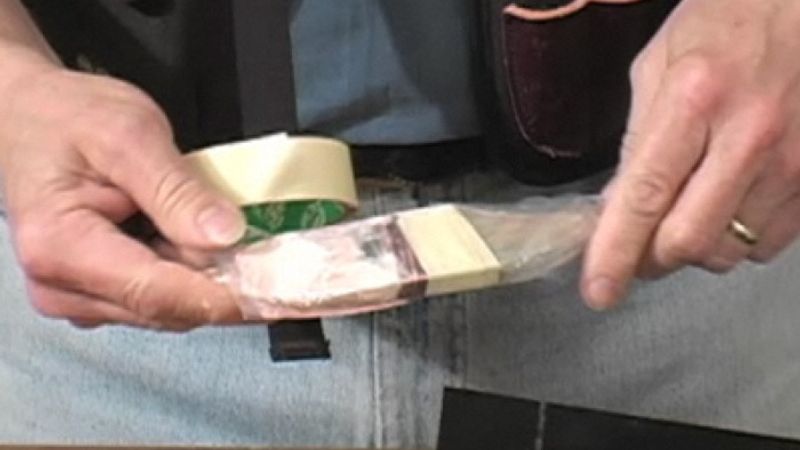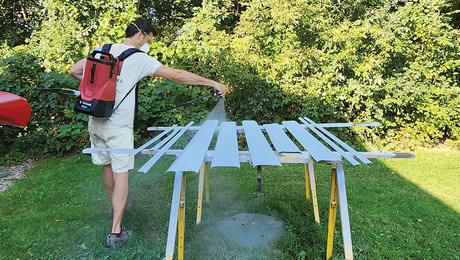Keep a Paintbrush From Drying Out Between Coats
Washing a brush after every coat of paint can be a real drag. Follow this tip and your bristles will stay straight, and the brush should stay wet for days.

Wet paintbrush storage
Don R. Simon, Jr., from Bremerton, Washington writes:
For years I have used plastic sandwich bags to store my wet paint brush till the next coat was ready or till the next workday. I would just open the bag and stuff the brush inside. The problem with this method is that it’s messy. Paint gets all over the opening of the bag, and the brush’s handle.
Here’s a method that I’ve devised that allows me to minimize the mess while still achieving a virtually air-tight seal. As shown in the drawing (location), I cut a small wedge out of the side of the bag about 1 1/2 in. above its corner. Now I can insert the wet brush handle first, with the opening of the bag wide enough to keep the wet bristles from making contact with the self-sealing strip. Once the brush is in the bag I pull the handle down until the brush neatly tucks into the corner against the bottom of the bag. Next, I wrap the bag around the brush, seal its ziplock strip and wrap a piece of tape around the whole thing to keep it tightly bound. The wet brush will stay fresh for days.
This also works great for clean brushes that are dry and ready to store. Just wrap the excess part of the bag around the brush and secure with some tape or rubber band. Your clean brush now has the bristles protected and the bag is ready if you wish to reuse it to store that brush when it is full of paint.
For more information:



























View Comments
I have a method that is free and takes less time: "Repurpose" the plastic handled bags from a trip to the grocery store--a different bag each time, although you can re-use the bag.
(Continued)
To bag the wet brush:
Turn the bag inside out
Put your hand into the bag
Use your "gloved" hand to grab the bristle end of the brush
Keep holding the bristle end. Use your other hand to pull the bag over the brush, rightside out.
Twist the excess plastic around the handle of the brush. No need to further secure the bag if the brush is going straight into the fridge. The bristles stay wet and pliable for days.
My tip keeps the paint brush good for a few days and it's EAZY! Just use "Glad Press & Seal". I wrap the paint brush with a piece a little bigger than the bottom part of the brush. The great thing about this product is that you can get a good air seal. Just unwrap when you are ready to reuse.
This method is good for hours, but if I am not going to use it again that day I'll put it in the refrigerator...It will be good the next day!
Forget about the bag. Just use cling wrap film. A few twists around the head of the brush ensuring all the wet paint bristles are covered and you're good to go
I like cling wrap too, which also works great for paint rollers.
For years, we've used alumuninum foil. At a minimun, this let's us get the brushes and rollers back to the shop for cleaning, rather than having to do it on the jobsite. Brushes and roller covers for oil-based paint can go in the freezer for long-term storage, since it won't freeze. If we've been using water-based/latex paint and won't need the gear again for a few days, we use the 'fridge.
We have a used mini-fridge that we use for this.
For oil-based paint, what could be easier than immersing brush or roller in a bucket of water? Oil and water don't mix, and water keeps the solvents from evaporating, so the paint virtually never dries. Using oil primer, I've done this for up to several weeks without a problem. After removing from the water, a light shake of the brush flings off any water droplets. As for the roller, on removing from the water, you might or might not want to roll out the remaining wet paint on a scrap surface, depending on the project.
For water-based stuff, I usually will put a brush in any handy plastic bag and freeze it for use the next day or so, but I have found some paints get 'gritty' from freezing, so I don't think I would use this method for other than a primer.
cling wrap or saran wrap work best...your brush or roller good to be used even after 3 - 5 days...no need refrigeration.
Proven!!!
The other reason to not wash it is the environmental impact paint has on the water supply. I know it must be done but doing it fewer times really helps. Paint is very difficult to get out of water, so the less that is in it the less your sewage company has to work to make that water useable again.
I second Gough's idea. I've used aluminum foil for years. It will keep a brush or roller (with the handle) from drying out for several days. Just make sure you wrap it tight.
Cling wrap is the way to go.
i always keep a roll in my workshop.
I wrap about 3 times around a roller, finishing it off by giving the cling wrap a diagonal twist to get out all the air and then tucking in the ends.
I have kept a roller from one weekend to the next.
I only keep paint brushes for a few hours because the paint will always begin to dry near the top of the bristles.
I usually use plastic wrap and it works great. I wrap the brush and put it in the refrigerator, and it lasts a good week.
Forget various wrappers, leave it in water. Easiest way is to use any fast-food cup with lid. Push the handle up through the straw hole in the lid and fill cup with water. Make sure the bristles are submerged but not touching the bottom. I use this method throughout the day as well.
Hi to all,
All I've read are very useful solutions to the dilemma of paint brush storage, however I am the inventor of a new paint accessory, the ECO Prazi Paint Brush Storage Lid. It is a lid that stores your brush for a quick break, phone call, lunch, overnight, and even multiple days on end. If you have a second google it or go to praziusa.com for a video demonstration and price. I am a full time painter and it was born out of necessity. Hope you enjoy!
friskypainter
For many years I've used a simple technique of folding two sheets of paper towel, running them under water, wringing out the excess and folding over and around my brush bristles - with care you can use the same paper towel multiple times during the day. When done just discard into the trash, simple cheap, no mess.
The new Paint Brush Storage Lid by Gadgetry is now available. Store your brush anytime needed. Just put in the lid and place on can. Press down to seal for overnight. It's available on Amazon. Here's another good one. Store an oil brush suspended in a gallon can of water. Use the lid to keep a sharp tip. Works every time. I've gone 3 days with success. Wipe off the water on a rag and go.
Now that's not an idea that I've thought of to keep paintbrushes in storage. I normally just have them rinsed off and cleaned then put away. If I need them again then it's easy peasy. I don't even have to worry about clashing colours and the like.
I'm looking at the storage solutions involving water and I'm thinking that I need to try that out! Something tells me that it might be a very messy endeavour though!
In the theatre world, we just submerse everything in water. The scenic artists who paint literally for a living are the ones who encourage it. We have a refrigerator in fact right next to us in the shop but I can keep a brush in water for an absurd amount of time. A friend of mine has 60-80 dollar fitches and they're good as new despite the submersion in water while wet for multiple days.
We forgot about some brushes and rollers one time and it had black latex primer and we thought we would have to throw away a few hundred dollars worth of stuff but all the black primer came off and the stuff returned back to it's original color.
I've honestly never heard of anyone using the refrigerator for brushes until now and I still don't see why. Submersion works for all types of paint as long as there is enough water to cover the brushes because the water in water based paint on the bristles can't evaporate if there's already water around and on top of it.